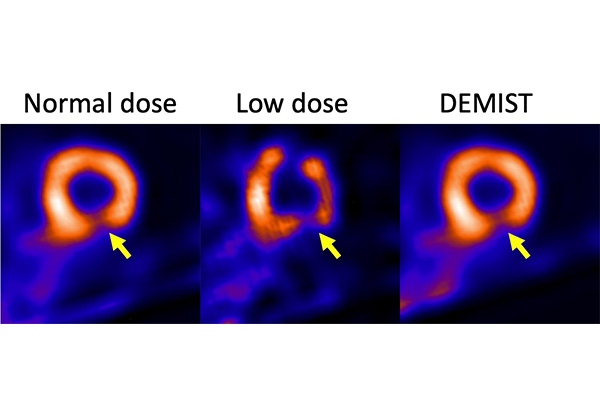DEMIST artificial intelligence tool may enhance usability of medical images
A deep-learning-based image denoising method developed by Abhinav Jha may improve detection of myocardial defects in low-count SPECT scans

Biomedical engineer Abhinav Jha, assistant professor in the McKelvey School of Engineering and of radiology at Mallinckrodt Institute of Radiology in the School of Medicine, both at Washington University in St. Louis, has long advocated that AI tools used in medical applications for image processing need to be evaluated based on clinical tasks, not visual appeal.
In a study published in IEEE Transactions on Radiation and Plasma Medical Sciences, Jha and his collaborators developed a tool that demonstrates potential to improve performance on clinical tasks. The tool has been developed in the context of denoising myocardial perfusion imaging (MPI) single-photon emission computed tomography (SPECT) images.
For doctors to obtain these images, which help evaluate blood flow to the heart muscle, patients first receive a dose of radioactive tracer and then remain stationary for up to 15 minutes during the scan. Reducing the dose of the tracer and/or the time required would benefit patients, streamline the scanning process, and reduce imaging cost. However, it would also reduce the quality of images produced in terms of the ability to visualize cardiac defects, the clinical task for which these images are acquired.
Inspired by our understanding of how the human visual system works, Jha’s team developed a detection-task-specific deep-learning-based approach for denoising these low-count MPI SPECT images such that the quality improves. The new tool, called DEMIST, leverages a deep learning framework to selectively clean MPI SPECT images while preserving features that influence detection tasks.
The researchers evaluated DEMIST’s effectiveness on anonymized clinical data from 338 patients who underwent MPI studies across two scanners. They found DEMIST outperformed both the low-dose scans and a commonly used task-agnostic denoising method on the task of detecting cardiac defects. Images denoised with DEMIST significantly enhanced detection of cardiac defects by a model observer. Notably, this was observed across both male and female patients, across different defect types, and using data from two different scanners. Additional mathematical analysis corroborated that DEMIST successfully preserved features crucial for detection tasks, thereby elevating observer performance.
“These results provide evidence for future clinical evaluation of DEMIST's potential to denoise MPI SPECT images,” Jha said. “I am excited about these findings since we are seeing that AI may have the potential to enhance the usability of medical images. By providing the possibility to reduce radiation dose and acquisition time, DEMIST offers possibilities to enhance the accuracy and efficiency of detecting myocardial perfusion defects, ultimately benefiting patient care and treatment outcomes.”
Rahman MA, Yu Z, Laforest R, Abbey CK, Siegel BA, Jha AK. DEMIST: A deep-learning-based detection-task-specific denoising approach for myocardial perfusion SPECT. IEEE Transactions on Radiation and Plasma Medical Sciences, online March 25, 2024. DOI: https://ieeexplore.ieee.org/document/10477616
This work was supported in part by the National Institute of Biomedical Imaging and Bioengineering of the National Institutes of Health (R01-EB031051, R56-EB028287 and R01-EB031962) and in part by the National Science Foundation CAREER Award (2239707).




